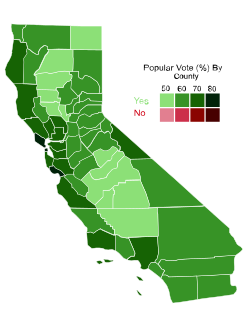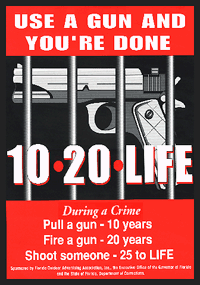A felony is traditionally considered a crime of high seriousness, whereas a misdemeanor is regarded as less serious. The term "felony" originated from English common law to describe an offense that resulted in the confiscation of a convicted person's land and goods, to which additional punishments including capital punishment could be added; other crimes were called misdemeanors. Following conviction of a felony in a court of law, a person may be described as a felon or a convicted felon.
Measure 11, also known as "One Strike You're Out", was a citizens' initiative passed in 1994 in the U.S. State of Oregon. This statutory enactment established mandatory minimum sentencing for several crimes. The measure was approved in the November 8, 1994 general election with 788,695 votes in favor, and 412,816 votes against.
In the United States, habitual offender laws have been implemented since at least 1952, and are part of the United States Justice Department's Anti-Violence Strategy. These laws require a person who is convicted of an offense and who has one or two other previous serious convictions to serve a mandatory life sentence in prison, with or without parole depending on the jurisdiction. The purpose of the laws is to drastically increase the punishment of those who continue to commit offenses after being convicted of one or two serious crimes.
Gregg v. Georgia, Proffitt v. Florida, Jurek v. Texas, Woodson v. North Carolina, and Roberts v. Louisiana, 428 U.S. 153 (1976), is a landmark decision of the U.S. Supreme Court. It reaffirmed the Court's acceptance of the use of the death penalty in the United States, upholding, in particular, the death sentence imposed on Troy Leon Gregg. The case is referred to by a leading scholar as the July 2 Cases, and elsewhere referred to by the lead case Gregg. The court set forth the two main features that capital sentencing procedures must employ in order to comply with the Eighth Amendment ban on "cruel and unusual punishments". The decision essentially ended the de facto moratorium on the death penalty imposed by the Court in its 1972 decision in Furman v. Georgia 408 U.S. 238 (1972).
Mandatory sentencing requires that offenders serve a predefined term for certain crimes, commonly serious and violent offenses. Judges are bound by law; these sentences are produced through the legislature, not the judicial system. They are instituted to expedite the sentencing process and limit the possibility of irregularity of outcomes due to judicial discretion. Mandatory sentences are typically given to people who are convicted of certain serious and/or violent crimes, and require a prison sentence. Mandatory sentencing laws vary across nations; they are more prevalent in common law jurisdictions because civil law jurisdictions usually prescribe minimum and maximum sentences for every type of crime in explicit laws.
Ewing v. California, 538 U.S. 11 (2003), is one of two cases upholding a sentence imposed under California's three strikes law against a challenge that it constituted cruel and unusual punishment in violation of the Eighth Amendment. As in its prior decision in Harmelin v. Michigan, the United States Supreme Court could not agree on the precise reasoning to uphold the sentence. But, with the decision in Ewing and the companion case Lockyer v. Andrade, the Court effectively foreclosed criminal defendants from arguing that their non-capital sentences were disproportional to the crime they had committed.
James v. United States, 550 U.S. 192 (2007), is a decision by the Supreme Court of the United States that held that attempted burglary could serve as a predicate felony under the federal Armed Career Criminal Act (ACCA), which provided that a person convicted of being a felon in possession of a firearm with three prior convictions for either serious drug offenses or violent felonies must be sentenced to a mandatory minimum 15-year prison term.

In the United States, sentencing law varies by jurisdiction. The jurisdictions in the US legal system are federal, state, regional, and county. Each jurisdictional entity has governmental bodies that create common, statutory, and regulatory law, although some legal issues are handled more often at the federal level, while other issues are the domain of the states. Civil rights, immigration, interstate commerce, and constitutional issues are subject to federal jurisdiction. Issues such as domestic relations, which includes domestic violence; marriage and divorce; corporations; property; contracts; and criminal laws are generally governed by states, unless there is federal preemption.

In the United States, each state and territory sets the age of consent either by statute or the common law applies, and there are several federal statutes related to protecting minors from sexual predators. Depending on the jurisdiction, the legal age of consent is between 16 and 18. In some places, civil and criminal laws within the same state conflict with each other.

The Armed Career Criminal Act of 1984 (ACCA) is a United States federal law that provides sentence enhancements for felons who commit crimes with firearms if they are convicted of certain crimes three or more times.

Capital punishment is a legal penalty in the U.S. state of Florida.
In the United States, the law for murder varies by jurisdiction. In many US jurisdictions there is a hierarchy of acts, known collectively as homicide, of which first-degree murder and felony murder are the most serious, followed by second-degree murder and, in a few states, third-degree murder, followed by voluntary manslaughter and involuntary manslaughter which are not as serious, followed by reckless homicide and negligent homicide which are the least serious, and ending finally in justifiable homicide, which is not a crime. However, because there are at least 52 relevant jurisdictions, each with its own criminal code, this is a considerable simplification.
In the state of Florida, the common law felony murder rule has been codified in Florida Statutes § 782.04.
Loss of rights due to criminal conviction refers to the practice in some countries of reducing the rights of individuals who have been convicted of a criminal offence. The restrictions are in addition to other penalties such as incarceration or fines. In addition to restrictions imposed directly upon conviction, there can also be collateral civil consequences resulting from a criminal conviction, but which are not imposed directly by the courts as a result of the conviction.
Abbott v. United States, 562 U.S. 8 (2010), is a decision by the Supreme Court of the United States that addressed the mandatory sentencing increase under federal law for the possession or use of a deadly weapon in drug trafficking and violent crimes. In an 8–0 decision, the Court ruled that 18 U.S.C. § 924(c), which required a minimum five-year prison sentence, was to be imposed in addition to any other mandatory sentence given for another crime, including the underlying drug-related or violent offense. The only exception to the five-year addition applied only when another provision required a longer mandatory term for conduct violating §924(c) specifically, rather than a mandatory sentence for another crime as the defendants had unsuccessfully argued.
In the United States, a seven-deadly-sins law for juvenile offenders is a law intended to address the increasing rates of violent crime among youth. The law has taken many forms in different state legislatures in the United States, however the "seven deadly sins" aspect always refers to the jurisdiction of the superior court over the trial of any juvenile 13–17 years old who allegedly committed murder, rape, armed robbery with firearm, aggravated child molestation, aggravated sodomy, aggravated sexual battery, or voluntary manslaughter. In the mid 1990s, numerous US states enacted seven-deadly-sins laws to combat so-called teen "superpredators," a predicted wave of remorseless teenaged criminals. However, this prediction did not come to fruition.

Proposition 36, also titled A Change in the "Three Strikes Law" Initiative, was a California ballot measure that was passed in November 2012 to modify California's Three Strikes Law. The latter law punishes habitual offenders by establishing sentence escalation for crimes that were classified as "strikes", and requires a mandatory minimum sentence of 25 to life for a "third-strike offense."
Sentencing reform is the effort to change perceived injustices in the lengths of criminal sentences. It is a component of the larger concept of criminal justice reform. In the U.S. criminal justice system, sentencing guidelines are criticized for being both draconian and racially discriminatory. Additionally, they are cited as the main contributor to the growing and excessive prison population known as mass incarceration.
Stokeling v. United States, 586 U.S. ___ (2019), was a United States Supreme Court case in which the court held that state robbery offenses that involve overcoming victim resistance count as "violent felonies" under the definition of that term under the Armed Career Criminal Act of 1984, even when only 'slight force' is required. Under the Armed Career Criminal Act, defendants with three or more violent felonies can face higher sentences when subsequently convicted of a federal firearms-related offense. This case upheld a ruling by the 11th Circuit.
Rape laws vary across the United States jurisdictions. However, rape is federally defined for statistical purposes as:
Penetration, no matter how slight, of the vagina or anus with any body part or object, or oral penetration by a sex organ of another person, without the consent of the victim.





